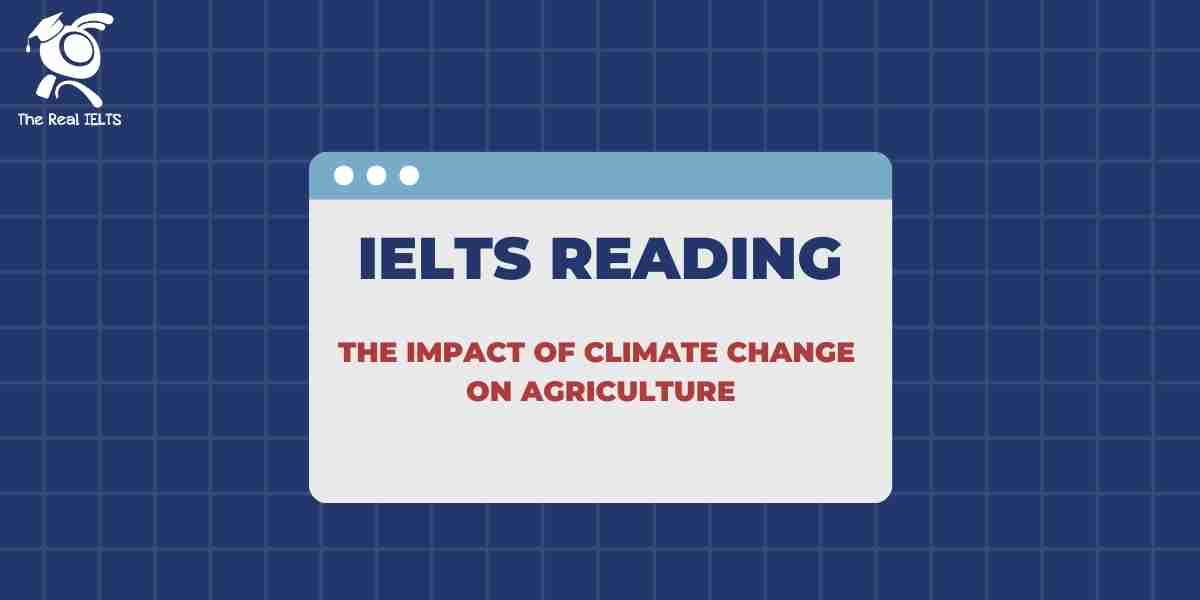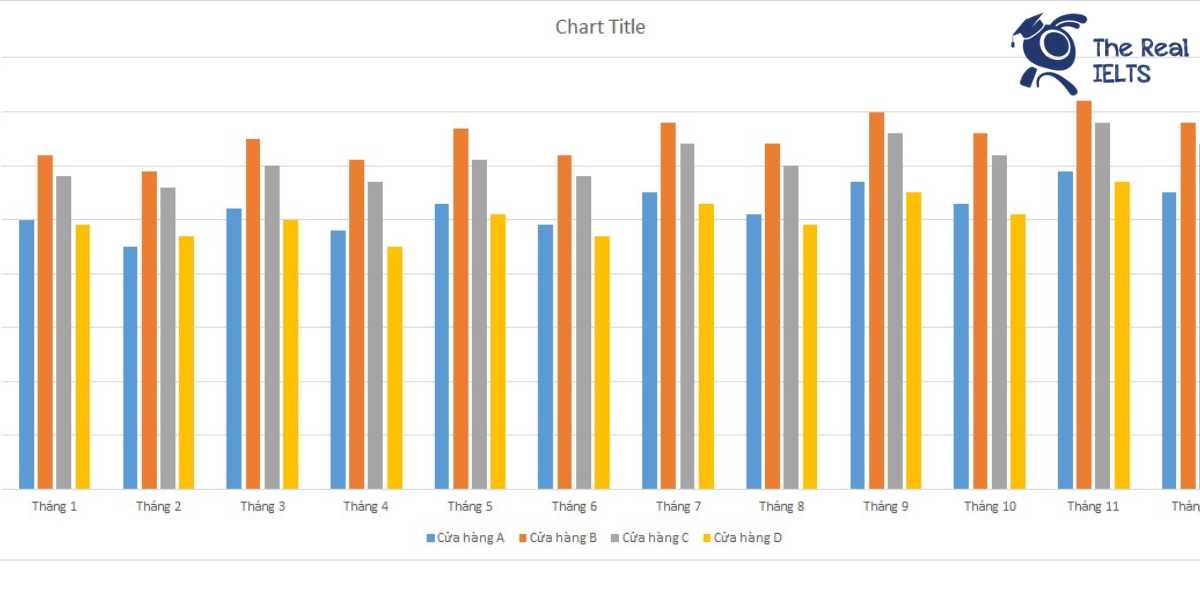Đề thi IELTS Reading có tiêu đề “The Impact of Climate Change on Agriculture”
Nhớ đọc thêm các bài luyện thi IELTS nhé.
IELTS Reading:”The Impact of Climate Change on Agriculture“
The Impact of Climate Change on Agriculture
Climate change has emerged as one of the most pressing global challenges of the 21st century, with profound implications for agriculture. As the Earth’s climate continues to warm due to increasing concentrations of greenhouse gases in the atmosphere, the impacts on agriculture are becoming increasingly evident. These impacts manifest in various forms, including shifts in growing seasons, changes in precipitation patterns, and increased frequency of extreme weather events, all of which have significant consequences for food production, food security, and rural livelihoods.
One of the most direct effects of climate change on agriculture is the alteration of growing seasons. In many regions, warming temperatures have led to an extension of the growing season, allowing for longer periods of crop cultivation. While this might seem beneficial at first glance, it also brings about challenges. Warmer temperatures can accelerate the life cycle of crops, leading to earlier maturation and potentially lower yields. Additionally, the extended growing season can result in increased pest and disease pressure, as these organisms also thrive in warmer conditions. For instance, the proliferation of certain insect pests, which were previously limited by colder temperatures, has expanded into new areas, posing significant threats to crops.
Precipitation patterns, another critical factor for agriculture, have also been disrupted by climate change. In some regions, rainfall has become more erratic, with longer dry spells followed by intense, short-lived rainfall events. This variability in precipitation can lead to both droughts and floods, each with devastating effects on agriculture. Drought conditions can severely limit water availability for crops, leading to reduced yields or even total crop failure. On the other hand, intense rainfall can cause soil erosion, nutrient leaching, and waterlogging of crops, all of which can negatively impact agricultural productivity. In areas dependent on rain-fed agriculture, these changes in precipitation patterns pose a significant threat to food security.
Moreover, the increased frequency and intensity of extreme weather events, such as hurricanes, cyclones, and heatwaves, further exacerbate the challenges faced by agriculture. These events can cause immediate and severe damage to crops, livestock, and infrastructure, leading to substantial economic losses. For example, heatwaves can cause heat stress in crops, reducing their growth and productivity. Similarly, strong storms can destroy fields, uproot trees, and cause widespread devastation to farming communities. The long-term impacts of such events can also be profound, as they can lead to shifts in land use patterns, displacement of farming communities, and loss of agricultural biodiversity.
The impacts of climate change on agriculture are not uniform across the globe; they vary depending on the region and the type of agriculture practiced. In temperate regions, some crops may benefit from warmer temperatures and longer growing seasons, while in tropical and subtropical regions, the negative impacts are likely to be more pronounced. Smallholder farmers, who often rely on traditional farming practices and have limited access to resources, are particularly vulnerable to the impacts of climate change. These farmers are often located in regions that are already prone to climate variability, and they have limited capacity to adapt to changing conditions.
In response to these challenges, adaptation strategies are essential to ensure the sustainability of agriculture in a changing climate. These strategies include the development and adoption of climate-resilient crop varieties, improved water management practices, and the diversification of agricultural systems. For example, breeding crops that are more tolerant to heat, drought, or salinity can help mitigate the negative impacts of climate change on crop yields. Similarly, implementing efficient irrigation systems and water conservation practices can help farmers cope with reduced water availability. Diversifying agricultural systems by incorporating agroforestry, mixed cropping, and integrated farming practices can also enhance the resilience of farming systems to climate change.
In addition to adaptation, mitigation efforts are crucial to reducing the long-term impacts of climate change on agriculture. Agriculture itself is a significant contributor to greenhouse gas emissions, particularly through practices such as deforestation, livestock production, and the use of synthetic fertilizers. Transitioning to more sustainable agricultural practices, such as agroecology, organic farming, and conservation agriculture, can help reduce emissions and sequester carbon in soils. For instance, agroecological practices that promote soil health, such as cover cropping, crop rotation, and reduced tillage, can enhance the carbon sequestration potential of agricultural lands while also improving soil fertility and crop resilience.
Furthermore, global cooperation and policy support are essential to addressing the impacts of climate change on agriculture. International agreements, such as the Paris Agreement, play a vital role in mobilizing resources and coordinating efforts to combat climate change. National governments also have a crucial role in developing and implementing policies that support climate-smart agriculture, provide financial assistance to farmers, and promote research and innovation in climate adaptation and mitigation.
In conclusion, the impact of climate change on agriculture is multifaceted and complex, with far-reaching consequences for food security, rural livelihoods, and the global economy. The challenges posed by climate change require a concerted effort from all stakeholders, including farmers, researchers, policymakers, and the international community. By developing and implementing effective adaptation and mitigation strategies, it is possible to enhance the resilience of agricultural systems to climate change and ensure the sustainability of food production in the face of an uncertain future.
Đề bài thi IELTS Reading
Multiple Choice Questions (Câu hỏi trắc nghiệm)
- What is one of the most direct effects of climate change on agriculture?
- A. Shortened growing seasons
- B. Increased rainfall
- C. Alteration of growing seasons
- D. Decreased pest pressure
- How does warmer temperature affect crops according to the passage?
- A. It extends their maturation period.
- B. It increases crop yields.
- C. It accelerates their life cycle.
- D. It makes them more resistant to diseases.
- Which of the following is NOT mentioned as a consequence of erratic rainfall patterns?
- A. Droughts
- B. Soil erosion
- C. Floods
- D. Increased water availability
- What is the impact of heatwaves on crops?
- A. Increased growth rate
- B. Heat stress reducing productivity
- C. Increased pest resistance
- D. Enhanced soil fertility
- In which regions are the negative impacts of climate change on agriculture likely to be more pronounced?
- A. Temperate regions
- B. Arctic regions
- C. Tropical and subtropical regions
- D. Coastal regions
- What is a significant adaptation strategy mentioned in the passage?
- A. Relying more on rain-fed agriculture
- B. Developing climate-resilient crop varieties
- C. Abandoning traditional farming practices
- D. Increasing the use of synthetic fertilizers
- What role do international agreements like the Paris Agreement play according to the passage?
- A. They reduce the cost of farming equipment.
- B. They help in mobilizing resources to combat climate change.
- C. They increase agricultural productivity.
- D. They prevent droughts and floods.
- Which of the following practices is suggested to help reduce greenhouse gas emissions from agriculture?
- A. Using more synthetic fertilizers
- B. Expanding livestock production
- C. Transitioning to agroecology
- D. Deforestation
- What is the main idea of the passage?
- A. Climate change has little effect on global agriculture.
- B. Climate change poses significant challenges and requires adaptation and mitigation in agriculture.
- C. Only tropical regions are affected by climate change.
- D. Agriculture is unaffected by extreme weather events.
- How does climate change affect smallholder farmers?
- A. They have ample resources to adapt.
- B. They are less vulnerable to climate change.
- C. They are particularly vulnerable due to limited resources.
- D. They benefit from erratic weather patterns.
True/False/Not Given
- Warmer temperatures always benefit agricultural productivity.
- True
- False
- Not Given
- Drought conditions have no effect on crop yields.
- True
- False
- Not Given
- The passage mentions that heatwaves help increase crop yields.
- True
- False
- Not Given
- According to the passage, all regions experience the same impact from climate change on agriculture.
- True
- False
- Not Given
- The Paris Agreement focuses solely on agricultural issues.
- True
- False
- Not Given
Yes/No/Not Given
- Does the author believe that climate change impacts are manageable without any adaptation strategies?
- Yes
- No
- Not Given
- Does the author suggest that more traditional farming practices should be abandoned?
- Yes
- No
- Not Given
- Does the passage imply that temperate regions will suffer more from climate change than tropical regions?
- Yes
- No
- Not Given
- Does the author mention that extreme weather events can lead to a complete failure of crops?
- Yes
- No
- Not Given
Matching Information (Nối thông tin)
- Match the information with the correct paragraph:
- A. Discussion of precipitation changes and their impact on agriculture.
- B. Mention of the role of international agreements in addressing climate change.
- C. Explanation of adaptation strategies for climate change in agriculture.
- D. The impact of heatwaves on agricultural productivity.
Matching Headings (Nối tiêu đề với đoạn văn)
- Match the following headings to the correct sections of the passage:
- A. “Challenges of erratic weather patterns”
- B. “The role of international cooperation”
- C. “Impact of warming temperatures on crops”
- D. “Strategies for adapting to climate change”
Matching Features (Nối đặc điểm)
- Match the following features to their corresponding descriptions:
- A. Increased pest pressure
- B. Erratic rainfall patterns
- C. Drought conditions
- D. Development of climate-resilient crops
Matching Sentence Endings (Nối phần kết câu)
- Complete the following sentences by matching them with the correct endings:
- A. Climate change is likely to extend growing seasons, but…
- B. Droughts caused by erratic rainfall patterns can…
- C. International agreements such as the Paris Agreement are crucial because…
- D. Agroecological practices can help reduce greenhouse gas emissions and…
- …also increase the frequency of pests and diseases.
- …mitigate the impact of climate change on agriculture.
- …result in significant crop failure.
- …they coordinate global efforts to combat climate change.
Sentence Completion (Hoàn thành câu)
- Warmer temperatures can lead to __________ in the life cycle of crops.
- Erratic rainfall patterns may result in __________ and floods.
- Smallholder farmers are particularly vulnerable because they have __________ to adapt to changing conditions.
- __________ is one of the practices that can reduce greenhouse gas emissions from agriculture.
Summary, Note, Table, Flow-chart Completion (Hoàn thành tóm tắt, ghi chú, bảng biểu, biểu đồ dòng chảy)
28-29. Complete the following summary using words from the passage:
Climate change is having a significant impact on agriculture, with warmer temperatures altering growing seasons and increasing the pressure from pests and diseases. Erratic rainfall patterns contribute to both __________ and __________, making agriculture increasingly challenging, especially for smallholder farmers. Adaptation strategies such as developing __________ crop varieties and improving water management practices are essential for maintaining food security.
Diagram Label Completion (Hoàn thành nhãn của sơ đồ)
30-31. Label the diagram below based on information from the passage:
A diagram of a farming field affected by climate change with labels for:
- A. Drought impact
- B. Flood impact
Short Answer Questions (Câu hỏi trả lời ngắn)
- What is one adaptation strategy that can help agriculture cope with reduced water availability?
- How does climate change affect the timing of the growing season?
- Which practice can help reduce greenhouse gas emissions by improving soil health?
- What is one example of an extreme weather event mentioned in the passage?
Multiple Choice (Câu hỏi trắc nghiệm)
- Which factor is NOT a direct consequence of climate change on agriculture?
- A. Increased soil fertility
- B. Alteration of growing seasons
- C. Increased pest pressure
- D. Erratic rainfall patterns
- What is one way that agroecological practices contribute to climate change mitigation?
- A. By increasing the use of synthetic fertilizers
- B. By enhancing carbon sequestration in soils
- C. By expanding livestock production
- D. By encouraging deforestation
- Which region is most likely to benefit from longer growing seasons due to climate change?
- A. Temperate regions
- B. Tropical regions
- C. Polar regions
- D. Coastal regions
- What is one reason why smallholder farmers are particularly vulnerable to climate change?
- A. They have access to advanced technology.
- B. They rely on traditional farming practices.
- C. They are located in regions with stable weather patterns.
- D. They have abundant financial resources.
- What is the main role of international agreements in addressing climate change according to the passage?
- A. They increase global agricultural productivity.
- B. They help coordinate global efforts to combat climate change.
- C. They focus on economic development.
- D. They prevent natural disasters.
Đáp án bài thi IELTS Reading
Multiple Choice Questions (Câu hỏi trắc nghiệm)
- C. Alteration of growing seasons
- C. It accelerates their life cycle.
- D. Increased water availability
- B. Heat stress reducing productivity
- C. Tropical and subtropical regions
- B. Developing climate-resilient crop varieties
- B. They help in mobilizing resources to combat climate change.
- C. Transitioning to agroecology
- B. Climate change poses significant challenges and requires adaptation and mitigation in agriculture.
- C. They are particularly vulnerable due to limited resources.
True/False/Not Given
- False
- False
- False
- False
- False
Yes/No/Not Given
- No
- No
- No
- Yes
Matching Information (Nối thông tin)
- A. Paragraph discussing erratic rainfall patterns and their impact on agriculture.
- B. Paragraph discussing the role of international agreements in addressing climate change.
- C. Paragraph discussing adaptation strategies for climate change in agriculture.
- D. Paragraph discussing the impact of heatwaves on agricultural productivity.
Matching Headings (Nối tiêu đề với đoạn văn)
- A. Paragraph discussing challenges of erratic weather patterns.
- B. Paragraph discussing the role of international cooperation.
- C. Paragraph discussing the impact of warming temperatures on crops.
- D. Paragraph discussing strategies for adapting to climate change.
Matching Features (Nối đặc điểm)
- A. Increased pest pressure – Warmer temperatures leading to accelerated life cycles of pests.
- B. Erratic rainfall patterns – Droughts and floods.
- C. Drought conditions – Reduced water availability for crops.
- D. Development of climate-resilient crops – Adaptation strategies for climate change.
Matching Sentence Endings (Nối phần kết câu)
- A-1. …also increase the frequency of pests and diseases.
- B-3. …result in significant crop failure.
- C-4. …they coordinate global efforts to combat climate change.
- D-2. …mitigate the impact of climate change on agriculture.
Sentence Completion (Hoàn thành câu)
- acceleration
- droughts
- limited resources
- Agroecology
Summary, Note, Table, Flow-chart Completion (Hoàn thành tóm tắt, ghi chú, bảng biểu, biểu đồ dòng chảy)
28-29.
- droughts
- floods
- climate-resilient
Diagram Label Completion (Hoàn thành nhãn của sơ đồ)
30-31.
- A. Drought impact – Reduced water availability
- B. Flood impact – Soil erosion and nutrient leaching
Short Answer Questions (Câu hỏi trả lời ngắn)
- Improved water management practices
- It can extend the growing season but also lead to earlier maturation.
- Agroecology
- Heatwaves
Multiple Choice (Câu hỏi trắc nghiệm)
- A. Increased soil fertility
- B. By enhancing carbon sequestration in soils
- A. Temperate regions
- B. They rely on traditional farming practices.
- B. They help coordinate global efforts to combat climate change.
Luyện tập bài khác ở bài viết:”100 bài luyện IELTS Reading 2024 – 2025“















